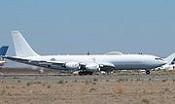8/31/2009
NEWS BRIEFS
Navy Launching Fastener Refit Program on Nuclear Communications Aircraft

The U.S. Navy’s E-6B Mercury nuclear strategic communications aircraft
The U.S. Navy plans to refit its 16-aircraft fleet of E-6B Mercury nuclear strategic communications jets.
“The refit will involve inspecting and replacing up to 15,000 fasteners on the aircraft’s wings,” according to a press release. “Fastener holes will also be widened and strengthened, extending the lifespan of the aircraft for another 20 years.”
“That’s the extent of the program, but it’s very labor intensive,” Bill Cain, the deputy director of the 566th Aircraft Maintenance Squadron, called the process “labor intensive.
“It will require an incredible amount of hand work to replace virtually all the wing skin fasteners,” Cain stated.
Operated by Strategic Communications Wing One at Tinker AFB in Oklahoma, the E-6B aircraft is used for strategic communications with the nation’s nuclear assets. The aircraft are based on the Boeing 707 airframe.
The work will be similar to work done on Air Force aircraft, although the Navy prefers a cold-working process to strengthen the fastening holes. The process involves the physical removal and inspection of each fastener as well as reworking the holes.
Work on the first E-6 will begin near the end of September with first aircraft completed by February and the final aircraft rolling out of the hangar in the spring of 2013.
The fastener work is part of an overall refit program that requires an estimated 28,000 man hours for each aircraft at a cost of $3 million each.
The program will bring about 35 new jobs to the base, with “considerable” training undertaken for the cold-working process
The additional workload, however, will require the hiring of additional workers, Mr. Baumann said. Approximately 70 workers will be assigned to the E-6 work; roughly half of those will come from additional hiring. The workers assigned to the SLEP project will also undergo considerable additional training in the cold-working process.
“There will be a combination of classroom training and a significant amount of on-the-job training,” stated Bill Baumann, the squadron director of the 566th AMXS. ©2009 GlobalFastenerNews.com
Related Stories:
• Bolt Installation Problems Hit Navy Subs

Share: